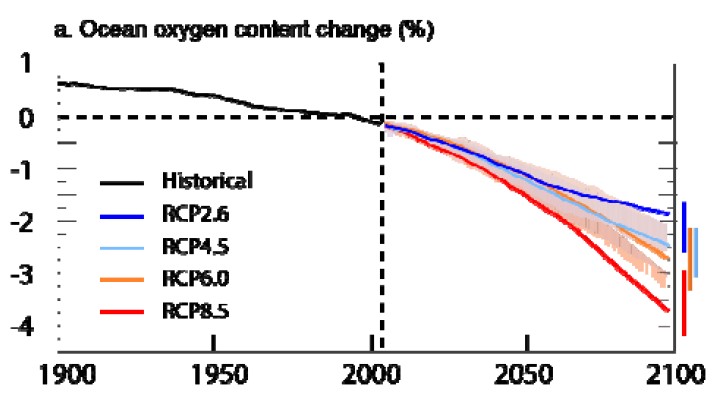by Matthew Wagstaff
Hiding away in the ocean section of the new IPCC report is a lesser known result of global climate change, ocean deoxygenation. Many effects of climate change such as increasing global temperatures, rising sea levels and ocean acidification are already well-known and somewhat in the public eye, however there are many other effects that are less well-known and less understood. Deoxygenation of the oceans is one of these lesser-known effects and is being caused by a number of factors. While the acidification of the ocean is caused by the uptake of carbon dioxide from the atmosphere, the deoxygenation of the ocean is mainly due to the increasing temperatures of the surface waters, which has two effects: the solubility effect and the stratification effect. From the IPCC report:
“It is very likely that global warming will lead to [further] declines in dissolved O2 in the ocean interior through warming-induced reduction in O2 solubility and increased ocean stratification. This will have implications for nutrient and carbon cycling, ocean productivity and marine habitats (Keeling et al., 2010).”

Figure 6.30: (a) Simulated changes in dissolved O2 (mean and model range as shading) relative to 1990s for RCP2.6,RCP4.5, RCP6.0 and RCP8.5.
These two effects are both driven by increases in the water temperature. Firstly the solubility effect is based on the fact that the solubility of gases in water decreases at higher temperatures, and so as ocean temperatures are increasing, oxygen and other dissolved gases are being released, or dissolving more slowly. Secondly, the stratification effect is a result of surface waters warming and thus becoming less dense.
This leads to the physical and chemical differences between water layers in the ocean becoming more pronounced and results in a reduction in transport of dissolved oxygen from the surface (where oxygen content is high due to interactions with the atmosphere) to subsurface layers. The CMIP5 climate models used by the IPCC predict this deoxygenation trend to continue “with reductions in mean dissolved O2 concentrations from 1.5 to 4% (2.5 to 6.5 μmol kg–1) in 2090s relative to 1990s for all RCPs (Figure 6.30a)”.
As well as these effects of climate change resulting in deoxygenation of the open ocean, there are also more specific processes occurring in the coastal oceans resulting in further deoxygenation.
“The modelled estimates do not take into account processes that are specific to the coastal ocean and may amplify deoxygenation. Recent observations for the period 1976–2000 have shown that dissolved O2 concentrations have declined at a faster rate in the coastal ocean (–0.28 μmol kg–1 yr–1) than the open ocean (–0.02 μmol kg–1 y–1, and a faster rate than in the period 1951–1975 indicating a worsening of hypoxia (Gilbert et al., 2010). Hypoxia in the shallow coastal ocean … is largely eutrophication-driven and is controlled by the anthropogenic flux of nutrients (N and P) and organic matter from rivers. If continued industrialisation and intensification of agriculture yield larger nutrient loads in the future, eutrophication should intensify (Rabalais et al., 2010), and further increase the coastal ocean deoxygenation.”
This section of the report describes how further deoxygenation causing hypoxia (low oxygen levels) is being driven by the process of eutrophication, due to the input of nutrients into the ocean by human activity. Naturally low levels of nutrients such as nitrogen and phosphorus generally limit algae growth, so when they are released into the ocean by human activity this can cause extensive productivity. The breakdown and decomposition of this large influx of organic matter from the algal bloom uses up oxygen and so oxygen levels are further depleted. Therefore if we continue to increase the amounts of these nutrients entering our coastal oceans, this problem will only get worse.
The combinations of these global and coastal effects are anticipated to increase the area and volume of current oxygen minimum zones and profoundly change nutrient and carbon cycling pathways, which will alter productivity and marine habitats.
One example of an oxygen minimum zone is in Tokyo Bay, where oxygen levels are very low due to eutrophication from plankton blooms so large they produce visibly red tides. In this low oxygen environment, jellyfish are some of the only complex marine organisms to survive. Because of this lack of competition, giant blooms of jellyfish are now seen each year!

Deoxygenation may deserve more attention than it currently gets from the media, and scientists. Coming up with a name that’s less of a mouthful may be a first step… ideas anyone?

The effects are certainly less visceral, than say, ocean acidification, for which you can demonstrate a coral skeleton dissolving in a simple lab experiment.
Pingback: Another Week of Climate Disruption News, January 5, 2014 – A Few Things Ill Considered
The first difficulty here is that not many people understand the importance of the ocean system to the planet’s health. There is good-ish information on fish stocks, but this is very much the short side of the story. Beyond this, people need to be clear on what the effect, long term, of deoxygenation will be.
Struggling to come up with an alternate word, but a headline ‘fish drown in water’ might point somewhere..